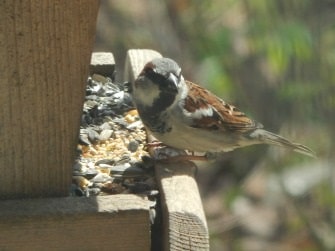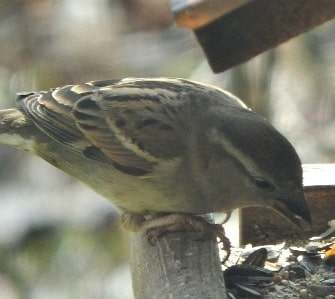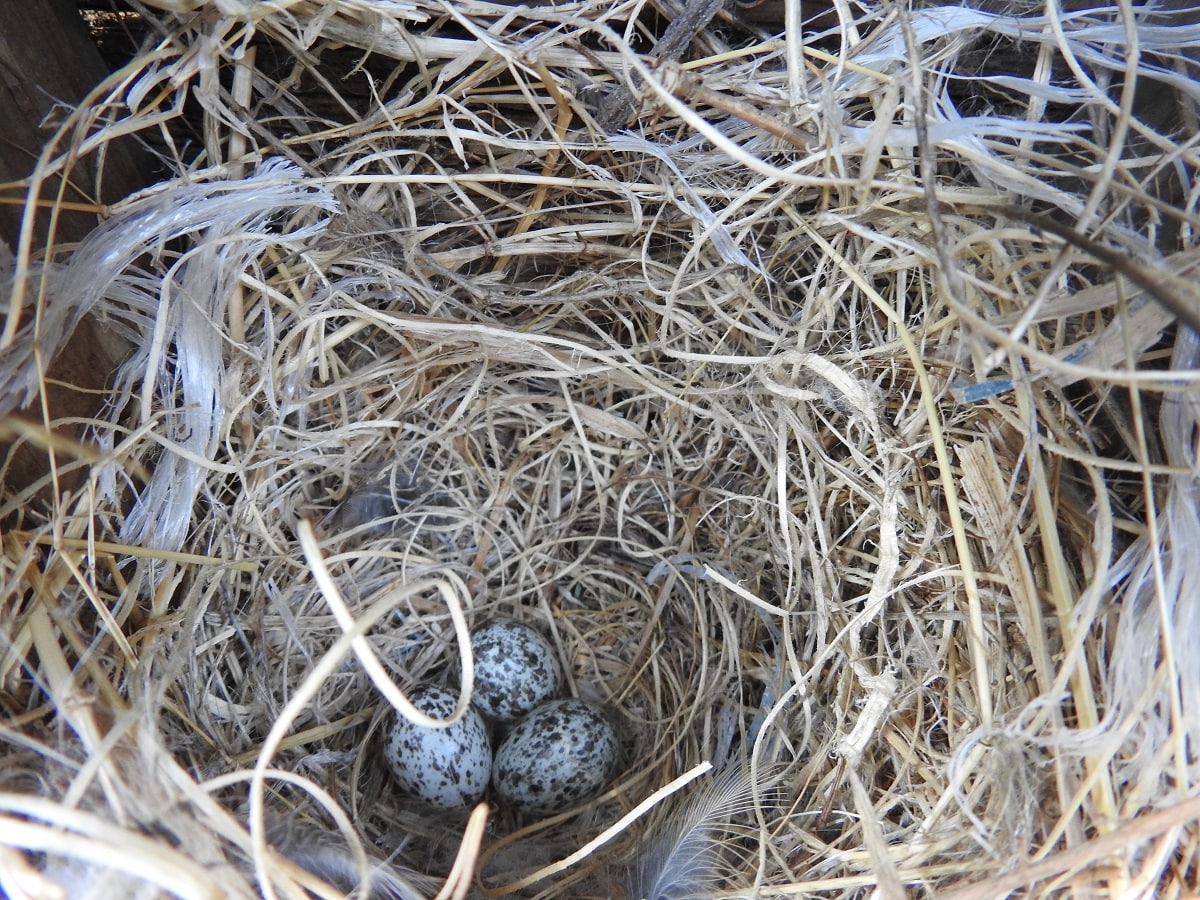The House Sparrows: Nesting Habits, Diet, and Mating Behaviors
Updated May 29, 2025
Introduction to New World
Initially, some of these birds were imported from England, hoping to control certain caterpillars that harm shade trees in the U.S. Unfortunately, that didn't work out.
According to the Cornell University All About Birds, the The first large introduction of these birds was in 1851 - 1852.
100 birds were brought to Brooklyn, NY, and successfully released. Additional releases in other areas of the country occurred from 1871 to 1874.
Its nesting range now includes the entire U.S. and well into Canada.
Mating and Nesting: Quick Glance
- Mating-Breeding: Non-mated birds may form pairs as early as January and go through July
- Nest Building - Egg Laying: Nest building can begin in February with first clutches laid late March - April. May raise multiple broods through August.
- Eggs - Incubation: Female will lay up to 7 eggs and both birds will share incubation for 12 days.
- Nestling Phase: Once the eggs hatch, the young will be in the nest for 15 - 17 days.
- Broods: House Sparrows may raise up to 4 broods each year.
Characteristics: Size, Field Marks
House Sparrows are 5 to 6 inches. The male has a distinctive appearance with a grayish-brown crown and nape, a black bib that extends down the chest, and a white cheek patch.
The back and wings are a mixture of shades of brown, black, and gray, and the underparts are a pale gray-brown.

The bill is thick and conical, and the eyes are dark brown. During the breeding season, the male's bill turns a bright yellow color, and the black bib becomes more prominent.
The female has a brown crown and a plain breast with a broad buff line over the eye.
Be careful when identifying female House Sparrows because they may look similar to female House Finches.
The female House Finch will have a stripped breast.
Although misnamed English Sparrow, and commonly known as the House Sparrow, or Common Sparrow, it is not particularly a native of England, and is not a sparrow.
It's thought to have its origin in the Mediterranean and is a member of the Weaver Finch family.
House Sparrow Call
Mating Habits
Their nesting, feeding, and mating habits can be observed easily due to their long multiple breeding seasons.
The courtship behaviors of the House Sparrow can begin as early as January and continue through July.
The males claim their nest sites and defend the immediate territory around the nest. There is no defined area outside the House Sparrow nest that the bird defends.
The male chirps by the sparrow nest site, trying to attract a female. When a female comes by, the male chirps louder and more quickly.
Sometimes the male will follow the female a short distance and hop or wing quiver around her if she passes by him.
Other males may join in trying to attract the same female.
Mating occurs throughout the breeding cycle, which is from March through early August.
Copulation takes place near the nest site and may occur several times during the day. Once the birds pair, nesting begins.

Do They Mate for Life?
House Sparrows will mate for life. However, they are not always monogamous. Up to 20 percent of the eggs or young can be from a male that is not her partner.
If one of the pair dies, the surviving bird will quickly pair with another.
So specifically, how do sparrows mate? What's the physical process. Like most birds, sparrows reproduce through sexual reproduction.
The male mounts the female to transfer sperm, which fertilizes the eggs inside the female.
The female then lays the fertilized eggs, which develop and hatch into chicks.
Dust Baths and Sunning Behavior
It's very common to see these birds dust bathing. To dust bathe, the House Sparrow hollows out a small divot in the dirt, lays down with open wings, and wiggles around in the dirt.
This behavior may be an effort to help remove parasites. Sunning looks the same as the bird is on the ground with wings spread out.
Nesting Habits
The nesting habits of House Sparrows play a significant role in the bird's life and activities. Since these birds use the nest nearly year around.
In spring and summer, the sparrow nest is used for raising young, if successful, up to four broods a season will be raised.
In fall and winter, it may be used for resting during the day and roosting at night.
The sparrow nest can be located in any available place in buildings, trees, and House Sparrow houses near human habitation.
The adaptability and the number of broods raised are what enable this bird's numbers to multiply.
The nest building is done almost year around. You are likely to notice most nest-building activity in spring from February - May.
Some refurbishing may be done during the fall but no egg laying is done.
Like most birds, the bulk of nest building is in spring just before breeding. Both the male and female build the nest.
Identifying a Sparrow Nest
To identify a sparrow's nest, look for its spherical shape, 8 to 10 inches in outside diameter, and made of coarse material on the outside, such as straw, twigs, paper, leaves, grasses, and other like materials.

The inside is lined with feathers or fine grasses. The image of the House Sparrow nest shows twine and feathers, also added to the nest.
The female begins laying eggs about a week after nest building begins. Typically, 5 eggs are laid but some nests can have up to 7 eggs.
Eggs and Incubation
The Sparrow's eggs are white to dull brown and speckled with brown. (See Photo Above)
For the most part, incubation of the eggs is done by the female with the male sitting on the eggs about 20 percent of the time.
Toward the end of incubation, the male may increase his egg sitting to 50 percent of the time.
House Sparrow incubation (gestation period isn't the term for birds) lasts for about 12 days and the young will leave the nest 15 to 17 days after hatching.
| Quick Reference Table: House Sparrow Nesting Habits | |
|---|---|
| Eggs | 1 - 7 |
| Incubation | 12 days |
| Nestling Phase | 15- 17 days |
| Broods | 1 - 4 |
Both the male and female feed the young. After the young birds have fledged, the male continues feeding the fledglings while the female begins laying eggs for another brood.
Where Do House Sparrows Build Their Nest?
Some people would ask, "where do House Sparrows not build their nests?" Any cavity above 5 feet, sometimes even closer to the ground, is suitable for nests.
They'll use any bird house they can get into and sometimes evict other bird species to take over a cavity.
They prefer old woodpecker holes, nooks, and openings of buildings close to humans. It's common to find their nest in the garden centers of big box stores.
House Sparrows are one of the most adaptable birds when it comes to selecting a nest site.
The Diet of House Sparrows
The House Sparrows diet consists mainly of small seeds. They will eat corn, oats, wheat, and other types of grain or weed seeds.
These birds primarily forage on the ground but will come to feeders for White Millet a favorite seed.
During spring and summer when feeding nestlings, the birds will switch their feeding habits and give their young a diet insects and spiders to eat for protein and moisture.
They readily eat scraps of food and bird seed provided by humans. These birds can be very aggressive at bird feeders and will keep other birds away while feeding.
House Sparrows and Native Birds
House Sparrows compete with many of our native bird species for nesting sites.
Among the native species it competes with are Bluebirds, Tree Swallows, and Purple Martins.
If you want native species such as Wrens, Chickadees, and others to nest in your birdhouses, you'll have to control the House Sparrows. Do this by removing nesting material quickly and often.
This can be a daunting task, as these birds are continually building nests.
Once a pair has built a nest, they will defend their nesting territory fiercely against the less aggressive species.
Why Do People Not Like These Birds?
Some people feel House Sparrows are bad because they are not native to the U.S. and will harm our native species or their eggs.
However, there are other native species that also destroy nest sites and prey on birds.
The common House Wren, for instance, is known to pierce the eggs of cavity-nesting birds. I've lost many Purple Martin and Bluebird eggs due to the Wrens.
The rise in numbers of Accipiter Hawks such as the Cooper's and Sharp-shinned in towns and cities will affect some species, especially at feeders.
But the truth is, House Sparrow numbers have declined both in their native country and in the United States.
For people interested, we've published the proper sparrow house dimensions and other considerations for providing safe nest sites.
In the birding world, they are not considered to be causing population declines in our native species.
While House Sparrows are non-natives and cause a small imbalance in nature, they won't cause the planet to spin out of control.
My thoughts, if you're hosting Bluebirds or Purple Martins, do what you can to protect them from House Sparrows.
If you like having them around, enjoy. They're not bad, they're just birds.
Natural Predators
Natural predators of House Sparrow include hawks such as Coopers, Sharp-shinned, and Kestrels. Other birds that eat House Sparrows include Owls and Shrikes.
In the nest, cats, dogs, raccoons, and black snakes will eat adults, young, and eggs.
How Long Do They Live?
The typical lifespan of the House Sparrow is 3 - 5 years in the wild with the current record of just over 13 years.
Only about 20 percent of young live past their first year.
Just under 60 percent of adult House Sparrows survive annually. Cold weather and food availability are factors in how long they live.
Related Reading






